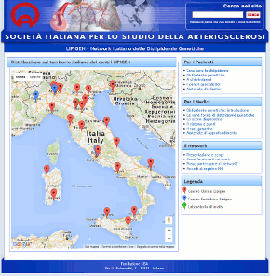 Rivista in lingua italiana
Rivista in lingua italiana
riservata ai Soci SISA
Ultimo numero:
Anno 15 • N.1/2024
SISANews
Variabilità regionale degli indici di infiammazione
Obesità, diabete, ipertensione, fumo di sigaretta, attività fisica, colesterolo LDL, colesterolo HDL e infine fattori genetici, sono gli elementi che più spesso vengono citati come fonte di variabilità dei biomarcatori dell'infiammazione come la proteina C reattiva ad alta sensibilità, le molecole di adesione cellulare di tipo 1 ed il fibrinogeno che sono consistentemente associati alla malattia aterosclerotica. Adesso si aggiunge un altro elemento di variabilità e cioè la sede geografica. In questo studio che viene dagli Stati Uniti si dimostra infatti che in donne sane il livello dei biomarcatori dell'infiammazione è più alto in alcuni stati, specie del sud est, e non è spiegato da differenze di etnia e dei tradizionali fattori di rischio cardiovascolare. Il perché non è chiaro.
![]()
Geographic Variation in Cardiovascular Inflammation among Healthy Women in the Women's Health Study
Cheryl R. Clark, Brent Coull, Lisa F. Berkman, Julie E. Buring, Paul M. Ridker.
PLoS ONE 2011;6:e27468
BACKGROUND: Geographic variation in traditional cardiovascular disease (CVD) risk factors has been observed among women in the US. It is not known whether state-level variation in cardiovascular inflammation exists or could be explained by traditional clinical risk factors and behavioral lifestyle factors.
METHODS AND RESULTS: We used multilevel linear regression to estimate state-level variation in inflammatory biomarker patterns adjusted for clinical and lifestyle characteristics among 26,029 women free of CVD. Participants derived from the Women's Health Study, a national cohort of healthy middle-aged and older women. Inflammatory biomarker patterns (plasma levels of high-sensitivity C-reactive protein (hsCRP), soluble intercellular adhesion molecule-1 (sICAM-1), and fibrinogen) were compared to state-level patterns of traditional CVD risk factors and global risk scores. We found that all three inflammatory biomarkers exhibited significant state-level variation including hsCRP (lowest vs. highest state median 1.3 mg/L vs. 2.7 mg/L, unadjusted random effect estimate 1st to 99th percentile range for log hsCRP 0.52, p<.001), sICAM-1 (325 ng/ml vs. 366ng/ml, unadjusted random effect estimate 1st to 99th percentile range 0.44, p<.001), and fibrinogen (322 mg/dL vs. 367 mg/dL, unadjusted random effect estimate 1st to 99th percentile range 0.41, p = .001). Neither demographic, clinical or lifestyle characteristics explained away state-level effects in biomarker patterns. Southern and Appalachian states (Arkansas, West Virginia) had the highest inflammatory biomarker values. Regional geographic patterns of traditional CVD risk factors and risk scores did not completely overlap with biomarkers of inflammation.
CONCLUSIONS: There is state-level geographic variation in inflammatory biomarkers among otherwise healthy women that cannot be completely attributed to traditional clinical risk factors or lifestyle characteristics. Future research should aim to identify additional factors that may explain geographic variation in biomarkers of inflammation among healthy women.

Area Soci
Eventi


 SISA LIPID ACADEMY - Corso avanzato di lipidologia clinica
SISA LIPID ACADEMY - Corso avanzato di lipidologia clinicaModena, 4-5 Luglio 2024
[continua a leggere]



Giornale Italiano Arteriosclerosi
HoFH today
 Rivista Italiana della
Rivista Italiana della
Ipercolesterolemia
Familiare Omozigote
Anno 5 • N.1/2023
Rivista NMCD
Diateca
[continua a leggere]
[continua a leggere]
Newsletter
il vostro indirizzo di posta elettronica
Progetto LIPIGEN

Nuovo sito dedicato al Progetto LIPIGEN
Progetto LIPIGEN - Vecchio portale
E' necessario essere loggati come utente
Lipigen per poter accedere alla pagina
PROject Statin Intolerance SISA
PROSISA – PROject Statin Intolerance SISA
E' necessario essere loggati come utente
PROSISA per poter accedere alla pagina
GILA - Lipoprotein Aferesi
Gruppo Interdisciplinare Lipoprotein Aferesi
(Accesso Gruppo GILA-Lipoprotein Aferesi)
E' necessario essere loggati come utente del Gruppo GILA per poter accedere
Gruppo Interdisciplinare Lipoprotein Aferesi
(Documentazione ad accesso libero)
Pagina informativa per medici e pazienti














